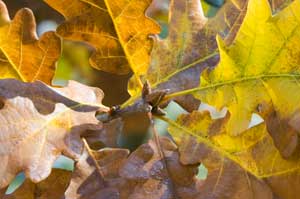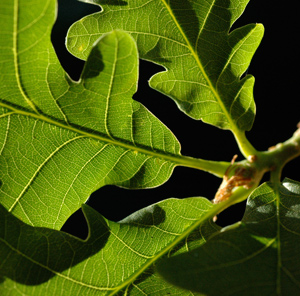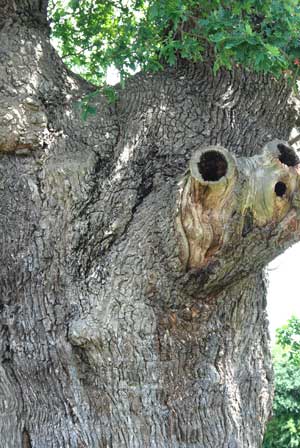The Oak

The oak has long been regarded as the King of the Forest and emblematic of the UK. It is the largest of our native, broad-leaved trees. There are two native species of oak; the sessile oak (Quercus petraea) and the pedunculate oak (Quercus robur). Oaks belong to the beech family, Fagaceae. They are long-lived trees that grow quite slowly, at least in their initial years. Both the pedunculate and sessile oak can grow to be very large trees - old trees can have a circumference of some 10 to 12 metres.
It is not always easy to distinguish between the sessile and pedunculate oak as the two species hybridise quite readily, and it may be difficult to find a ‘pure’ representative of each species. The lists below indicate some of the differences but a more detailed paper has been produced by Keele University based on a method developed by S.M .Potter.
Sessile Oak
- Found in west and northern Britain, the dominant species in upland oak woodlands.
- The acorns are not borne on stalks or peduncles. Do not yield as many acorns as pedunculate.
- Leaves not so deeply divided / cut as those of the pedunculate oak and have a longish stalk
- Sessile oak is considered by some to be better for long, straight boles. However, it has been suggested that some of the finest sessile oaks on lowland sites had their ‘origin’ on the continent, where the seed was selected deliberately for timber.
Pedunculate or English Oak
- Many to be found in the south and east, the dominant tree of deciduous woods in Britain. Also found in coppice woodland, high forest and was often planted in hedgerows. Both are long lived species – up to 500 years with some thought to be 700 to 1200 years old.
- Acorn borne on short stalks or peduncles
- Leaves have a short stalk or petiole, deeply cut blade (lamina)
- The pedunculate oak is not always a large and tall tree like those seen in the New Forest or on private estates. It can be stunted and grow into twisted and unusual shapes. Some of the Oaks of the old Sherwood Forest are like this.
 The wood from the Oak has been used extensively over the centuries. It is hard and durable, even when exposed to dampness. In former times, it was used for ship and boat building. In 1992, the remains of a 3,500 year old ship made of oak (and yew) was discovered near Dover. The boat was some 10+ metres in length and could carry cargo, livestock and passengers. Many see the boat as evidence of cross-channel trade at this time. Some 700 years ago, single oak trees were used to make boats (25+ feet in length) like the ‘salt boat’ discovered at Nantwich in Cheshire. By Elizabethan times, vast quantities of oak were being used in the building of ships (for the navy) and timber-framed houses. This contributed to the loss of oak forests and woodlands. The new Globe Theatre, London is made from Oak (from the Forest of Dean), using traditional techniques.
The wood from the Oak has been used extensively over the centuries. It is hard and durable, even when exposed to dampness. In former times, it was used for ship and boat building. In 1992, the remains of a 3,500 year old ship made of oak (and yew) was discovered near Dover. The boat was some 10+ metres in length and could carry cargo, livestock and passengers. Many see the boat as evidence of cross-channel trade at this time. Some 700 years ago, single oak trees were used to make boats (25+ feet in length) like the ‘salt boat’ discovered at Nantwich in Cheshire. By Elizabethan times, vast quantities of oak were being used in the building of ships (for the navy) and timber-framed houses. This contributed to the loss of oak forests and woodlands. The new Globe Theatre, London is made from Oak (from the Forest of Dean), using traditional techniques.
 Oak has been and still is used in furniture making. Some forms of oak are unusual and desirable, for example, Bog Oak and Brown Oak. The former is sometimes found in peat bogs, where it may have lain for hundreds of year, gradually acquiring a black colouration. Brown Oak, on the other hand, is formed by the action of the beefsteak fungus, Fistulina hepatica. This is one of the bracket fungi and when it grows on oak it produces a colour change in the heartwood. This is much sought after by furniture makers and wood turners. Oak and its products have had many other uses: for example, it was used for smoking food (sawdust), leather tanning (bark), iron smelting, feeding animals (acorns or mast for pigs) and charcoal making.
Oak has been and still is used in furniture making. Some forms of oak are unusual and desirable, for example, Bog Oak and Brown Oak. The former is sometimes found in peat bogs, where it may have lain for hundreds of year, gradually acquiring a black colouration. Brown Oak, on the other hand, is formed by the action of the beefsteak fungus, Fistulina hepatica. This is one of the bracket fungi and when it grows on oak it produces a colour change in the heartwood. This is much sought after by furniture makers and wood turners. Oak and its products have had many other uses: for example, it was used for smoking food (sawdust), leather tanning (bark), iron smelting, feeding animals (acorns or mast for pigs) and charcoal making.
 An oak tree is a habitat in itself and provides a home for many species of animals, plants and fungi. It provides food and shelter for many invertebrate species (insects and spiders); its leaves often show the scars of their predations. Its bark is an ideal substrate for many lichen and bryophyte species and the trunk and stem may be home to birds and small mammals. The roots establish mycorrhizal associations with various fungi (milkcap species e.g. Lactarius chrysorrheus and Lactarius quietus). These associations are symbiotic or mutualistic that is, they benefit both partners. The tree provides carbohydrates (formed in photosynthesis) to the fungus, which in turn donates some of the minerals that it has extracted from the soil with its extensive mycelium.
An oak tree is a habitat in itself and provides a home for many species of animals, plants and fungi. It provides food and shelter for many invertebrate species (insects and spiders); its leaves often show the scars of their predations. Its bark is an ideal substrate for many lichen and bryophyte species and the trunk and stem may be home to birds and small mammals. The roots establish mycorrhizal associations with various fungi (milkcap species e.g. Lactarius chrysorrheus and Lactarius quietus). These associations are symbiotic or mutualistic that is, they benefit both partners. The tree provides carbohydrates (formed in photosynthesis) to the fungus, which in turn donates some of the minerals that it has extracted from the soil with its extensive mycelium.
Many of the oaks in the UK fall into category of veteran or ancient trees. One such example is the Major Oak in Sherwood Forest. As its age is estimated at 800 years, it is conceivable that it is contemporaneous with the legendary Robin Hood though it would have been a young and slender tree then. Today, its circumference is about 33 feet (10 metres) with its branches spreading out over 92 feet - although slender steel poles now help support these. You can find details of ancient or veteran oaks in your neighbourhood, by visiting the interactive map of ancient trees produced by the Woodlands Trust.
Comments are closed for this post.
Discussion
I have three young pedunculate oaks in my park area in northeastern Kentucky, USA. I grew them from acorns I gathered from several trees in a shopping center area nearby. I am very proud of these trees.
Link restored.
This page
http://www.woodlands.co.uk/blog/flora-and-fauna/the-oak/
has link to
“Many of the oaks in the UK fall into category of veteran or ancient trees.”
http://www.woodlands.co.uk/blog/woodland-economics/ancient-and-veteran-trees/
but that is not found
Interesting page
The Oak , its a good article to share.. I will share this to my friends..
The forestry commission are having a seminar called ‘Whats wrong with Oak?’
You can see more in the EVENTS section in the SWOG group

The Ancient Tree Inventory’s new website with interactive map is here:
https://ati.woodlandtrust.org.uk/
HLeaf
17 November, 2018